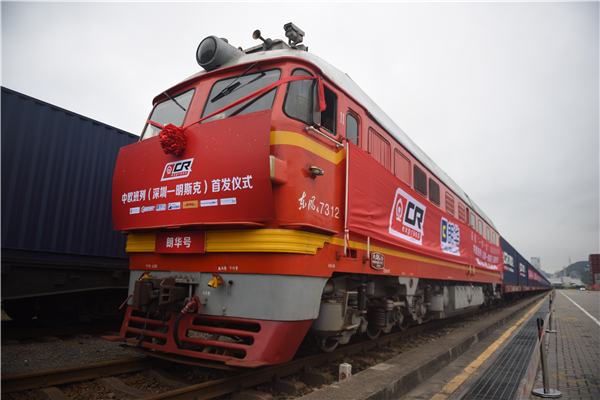
Photo taken on May 22, 2017 shows the first freight train of China Railway Express departing from the city of Shenzhen to European countries at Yantian Port in Shenzhen, South China’s Guangdong province. Freight train X8428, with a total travelling length of 9900 kilometers and bound for Minsk of Belarus, departed from Shenzhen’s Yantian Port on May 19, marking the opening of a new Sino-European freight train route starting from Shenzhen. [Photo/Xinhua]
BEIJING — China’s southern city of Shenzhen launched its first Europe-bound freight train on May 22, becoming the 29th Chinese city to introduce rail service to Europe.
The train, which was loaded with goods worth $8 million, including high-tech electronics, will arrive in Minsk, capital of Belarus, in 13 days.
The Shenzhen-Minsk freight train has turned the coastal city, a high-tech hub in the Pearl River Delta, into a bridge between the 21st Century Maritime Silk Road and the Silk Road Economic Belt.
“Goods such as rice and fruit from ASEAN countries like Vietnam and Laos can first be transported to Shenzhen by sea and then to Russia and Belarus by freight train,” said Li Wenhai, deputy director of the Guangzhou cargo transport center under the Guangzhou Railway Corporation.
On May 19, Xinjiang Uygur autonomous region launched its first freight train with cargo bound for India. The train set off from the regional capital, Urumqi, and will deliver goods to Lianyungang in east China’s Jiangsu province, where they will be shipped to India.
The booming international rail cargo service is a boost to trade between China and countries along the Belt and Road.
On May 14-15, Beijing held the Belt and Road Forum for International Cooperation, with leaders of participating countries pledging to build an open economy, ensure free trade and support the Belt and Road Initiative to enhance connectivity.
At the meeting, China vowed to provide massive financial support for Belt and Road construction and take new measures to strengthen cooperation with countries along the routes.
The cooperation momentum is continuously growing.
Shanghai Free Trade Zone (FTZ) will set up a service center to help companies break technical barriers to trade with Belt and Road countries, FTZ authorities said on May 22.
The service center will help Chinese companies learn more about markets along the Belt and Road and set up a new cooperative model of connectivity, according to the Shanghai FTZ administration.
The first crude oil from Myanmar had reached China via the China-Myanmar crude oil pipeline, China National Petroleum Corporation announced on May 19.
The 1,420-km-long cross-border pipeline is part of the China-Myanmar oil and gas pipeline project.
Strengthening financial connectivity is an important key to Belt and Road development.
China Construction Bank’s branch in Warsaw of Poland opened on May 22. It is the fifth branch of the Chinese bank in Europe.
So far, 13 Chinese commercial banks have joined a global payment innovation initiative to offer faster, more transparent and traceable cross-border payments for Chinese companies.
The initiative was launched in December 2015 by SWIFT, a global member-owned cooperative that provides financial messaging services. Since then, nearly 110 banks operating across more than 200 countries and regions, including almost all Belt and Road countries, have joined the initiative.
Belt and Road countries have huge potential for development. Chinese companies have been making robust investment abroad in sectors such as manufacturing and service industries, said Long Guoqiang, deputy head of the Development Research Center of the State Council.
Total trade between China and other Belt and Road countries exceeded $3 trillion between 2014 and 2016, and Chinese investment in these countries surpassed $50 billion.
